
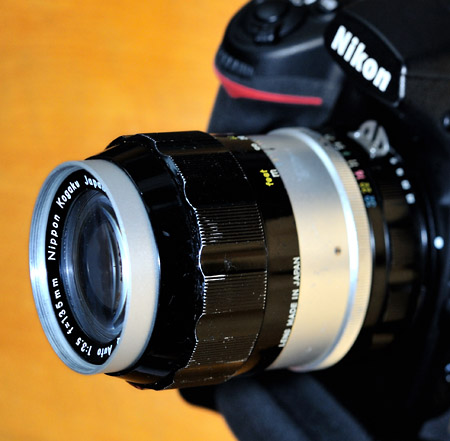
|
|
A 45-year-old 135mm telephoto lens mounted on a Nikon D700. You can use matrix metering and aperture priority mode as well! |
You want to buy an older - meaning manual focus without CPU - lens for your Nikon DSLR (or newer SLR)? First of all you should have a look at the manual of your camera body. Make sure that the lens you are interested in is not on the list of incompatible lenses or serial numbers.
If it is a lens without an automatic diaphragm (e. g. a "Reflex-Nikkor" or a shift lens / PC-Nikkor) you can use it.
For an automatic lens you have to have a closer look at the aperture ring. If it has two scales with f-stop numbers, a larger one towards the front of the lens and a smaller one towards the camera, then you have an AI, AI-s, Series E or factory AI'd lens. You can use it on your DSLR (or modern SLR). Enjoy it!
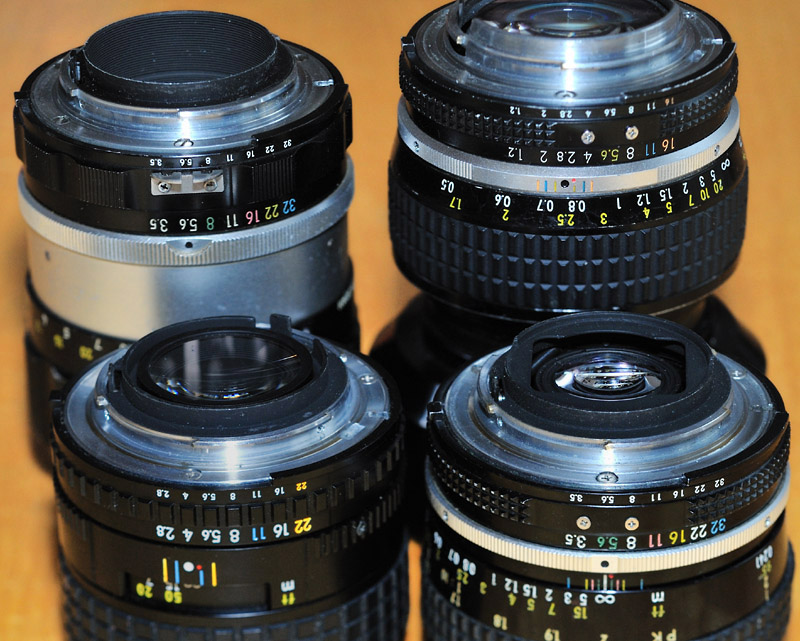
|
|
All these lenses are perfectly usable on every Nikon DSLR: in the first row on the left a Nikon Series E lens and on the right an AI lens, behind on the left a factory AI-modified lens and on the right an AI-S lens. A Nikon DSLR does not distinguish between different kinds of non-CPU manual focus lenses! |
Do not use non-AI lenses! The aperture ring of such a lens builds a ridge around the complete mount. This ridge can destroy coupling elements of your camera body! The only exception among the DSLRs is the Df, see below..
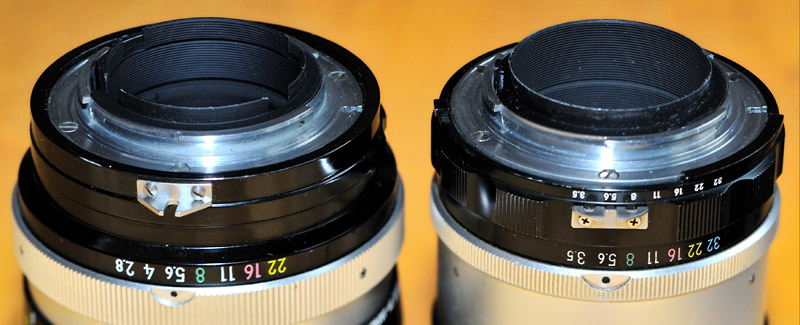
|
|
On the left there is a non-AI lens (meaning a lens build before 1977 in original condition). For comparison on the right there is a lens of the same age, but factory AI'd. |
In 1977 Nikon made an important change in the way the camera gets the aperture value from the lens. They introduced the Automatic Indexing (AI). It was no longer necessary to move the aperture ring back and forth to transfer the lens speed to the camera body, as Nikon photographers were used to do for more than 10 years.
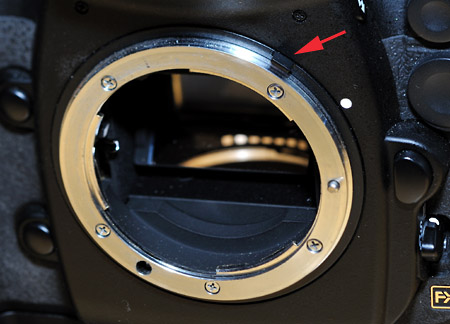
|
|
AI-coupling. A Nikon DSLR either has an AI and a CPU interface (like the D700 shown here) or a CPU interface only (like the D70 shown below). |
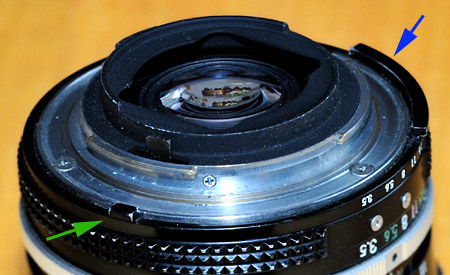
|
|
The mount of an AI lens. You can see the AI coupling ridge (blue arrow) and the EE servo coupling post (green arrow) |
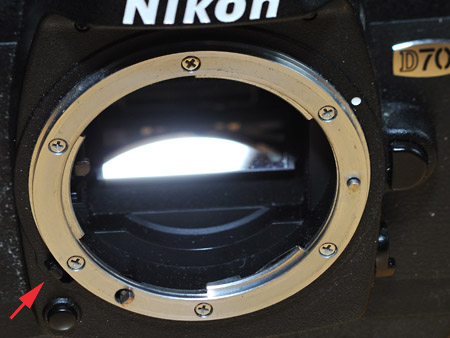
|
|
A modern camera body without an AI interface (CPU interface only). The small switch the arrow points to is the counterpart of the EE servo coupling post of the lens. The camera needs this switch in conjunction with AF oder AF-D lenses: if it is pushed, the body knows that the lens is set to the minimum aperture (greatest number). |
The old lenses were usable without any modification in conjunction with the new AI cameras in stop down metering. That was possible, only because the first generation of AI cameras (Nikkormat FT3, Nikon F2A, F2AS, EL2, FM, FE) offered the possibility to fold up the AI coupling unit. The professional F3, F4, F5 and F6 allow it too (but F5 and F6 only after modification through the nikon service). Other newer SLRs and all DSLRs with AI coupling (e. g. FA, F-801, F100, D1, D2, D3, D200, D300, D700, D7000) do not offer this. Thus non-modified lenses cannot be mounted on those cameras! If you try you risk the damage of the AI coupling of your camera!
But even cameras without AI coupling (with CPU interface only, e. g. F-401, F50, F80, D100, D70, D40, D90, D5100) use a communication element of AI lenses: the "EE servo coupling post" which was originally designed for the aperture control attachment DS-12. With the DS-12 attached the F2AS offered shutter priority mode - the post was used by the DS-12 for turning the aperture ring mechanically! DSLRs with CPU interface only have a small switch which indicates that a CPU lens with aperture ring is set to the minimum aperture. The switch is released by the above-mentioned post. By mounting a non-Ai lens you may destroy this switch.
Nikon itself offered the modifying of old lenses as a service, where the original aperture ring was replaced by an AI type ring. These so called 'factory AI modified' or 'factory AI'd' lenses are perfectly usable on nearly every Nikon body (you can identify them through the second aperture scale, see above). If you have the need to modify a lens you should first ask the Nikon service. Maybe they still have parts for doing that.
But not every lens was (or is) factory-modifiable. And so third party repair services offered an AI conversion as well. Still today you find such a service, search the web for 'Ai modification' or 'Ai conversion'. Or you may do the modification yourself too - for most lenses you just need a file.
If you want to buy a non-factory-modified lens, the problem is to detect a proper modification. It's not possible to give you rules for that! But I will show you examples of modified lenses below.
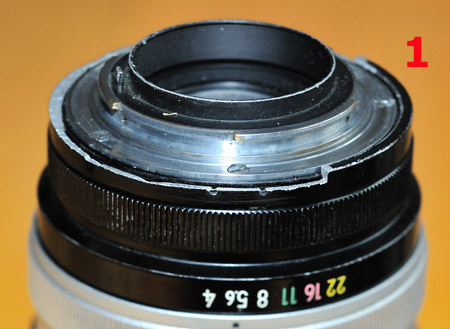
|
The way to modify a lens is to remove the aperture ring and to file away the ridge except for the bit you need for the AI coupling. I never saw a modification including the EE servo coupling post. Before 1987 this was a very exotic post, only needed for the DS-12, which was used only by a couple of professional photographers at the end of the 70s. But with the announcement of the F-401 things changed. That was the first camera body with a CPU interface only. With an exemplar of that class of cameras you have only manual mode and no metering if a non-CPU lens is mounted. The EE servo coupling post is not needed for that, but to avoid clashes, the ridge of the aperture ring must be filed complete around the mount (apart from the bit for the AI-coupling). Because most AI conversions were made in the first 10 years after the introduction of the AI technique, only about 60 to 80 degrees of the ridge were filed in most cases. That is enough for a body with AI coupling (except for the F2AS in conjunction with the DS-12, of course). But these modifications are not usuable for CPU interface only cameras!
Example 1 shows a Nikkor 200mm f/4 from the beginning of the 60s, AI-modified by myself (admire my perfect workmanship ;). It works fine on my D700 and on my D70 as well. But even this modification is not perfect. The original ridge around the mount of the old lenses differs in size from lens to lens. The 200mm has only a very small ridge. It touches the AI coupling of my D700 by just a fraction of a millimetre, but narrowly misses the coupling of a F2AS. A way to solve this could be to make the end of the ridge a bit bigger (as it was made with example 3). The comparison below shows the problem of the ridge size.
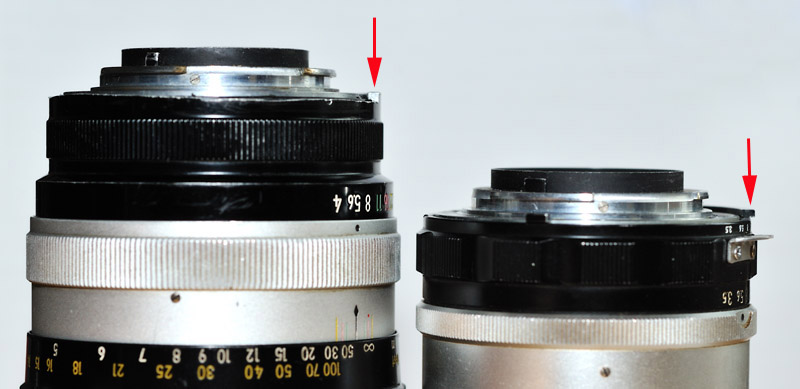
|
|
The size and form of the AI coupling ridge is a critical point. The rigde of the DIY modified lens on the left is too small compared to a factory modified lens. Because the AI couplings of the cameras differ in size from model to model, you should carefully try whether a particular combination works. |
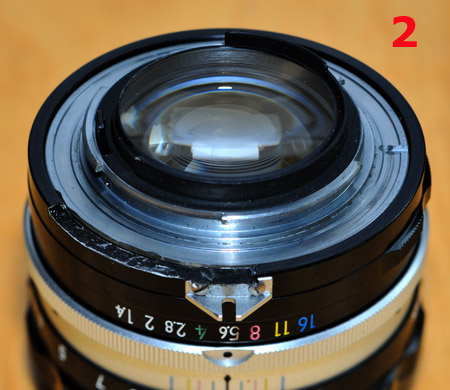
|
|
|
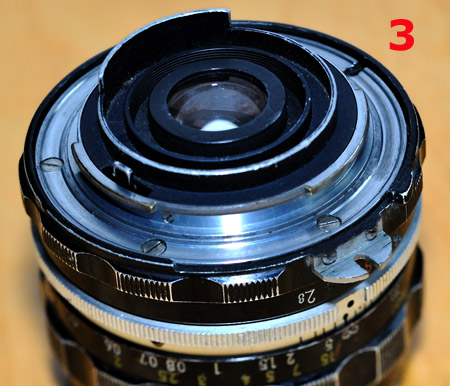
|
What is the reason why I do such things? The coating of the old lenses is significantly worse to the one of modern lenses. That is good for UV photography. And the Nikkor 200mm has a very good reputation for the use in UV light. I payed only 20 euros for this lens, but I had to modify it for the use on my D70 UVIR. And here comes the second problem of this modification: UV photography with natural light means I stand in the blazing sun, my D70 UVIR is mounted on a tripod, on the lens there are a couple of filters for eliminating visible and IR light and i have to expose around 15 seconds at F11. Under such conditions my 200mm lens produces a kind of haze on one half of the frame. I found out that it is caused by stray light coming through somewhere at the mount. I guess that is a result of my modification. I help myself by wrapping a piece of aluminium foil around the bayonet mount.
The second example shows a 50mm f/1.4 Nikkor from the middle of the 60s. As explained above, this modification does not work on a CPU interface only camera. On every AI camera I tried it works fine. You can see that the modification was done without removing the aperture ring. I can understand that, because the way to remove the ring differs from lens to lens. And if you do not have repair documentation for the lens it can drive you crazy!
Example 3, an old Nikkor 35mm f/2.8, shows a very well done modification. But even this lens is not usable on a CPU interface only camera.
At last a word about the position of the AI coupling ridge for the case that you want to make a modification by yourself: If you set an AI lens to its maximum aperture (meaning smallest number) before you mount it to the camera, you will see that the AI coupling of the camera body is moved only very slightly. Practically, that is the same for every AI lens, independent of the lens speed. Thus for determining the correct position of the AI ridge you can use any lens with an AI interface as a model!
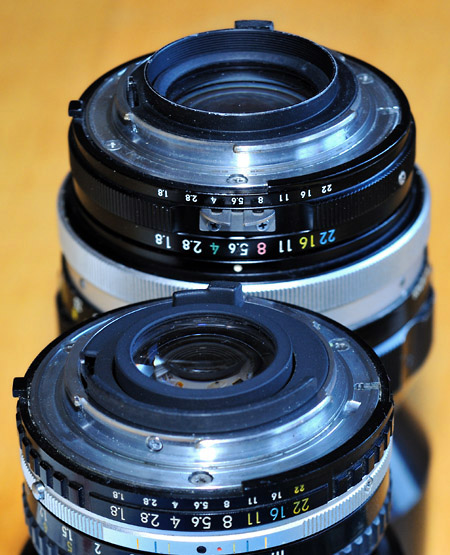
|
If you don't have a model, you can use the photo on the right for determining the correct position. As you can see, there are slight differences in the exact position of the ridge. Maybe that was a way for Nikon to invoke a lens specific exposure correction. For orientation you can use the smaller aperture ring. On the front lens, the ridge begins at about 2/3 stops over F8; on the lens behind at about 1/3 stop over F8. That is between 4 2/3 and 5 stops over the lens speed. If your modification is within this range everything should work fine. I tried the lenses shown here on my D700 by setting the menu to a F1.8 lens - then, if I set the aperture ring to 1.8 the D700 shows 'F1.8' in the display for both lenses. If I lie and set the camera menu to a F1.2 lens, both lenses start in the display at 'F1.2'. The same behaviour occured for F5.6.
In November 2013 Nikon presented a new full-frame DSLR from their model kit: the Df. Except for it's silly retro-style design the Df has another unusual and for a DSLR unique detail: it allows to fold up the AI coupling unit. The cameras of the first AI generation (and also later professional models) have the same feature. It allows mounting of non-AI lenses (if the coupling unit is up).
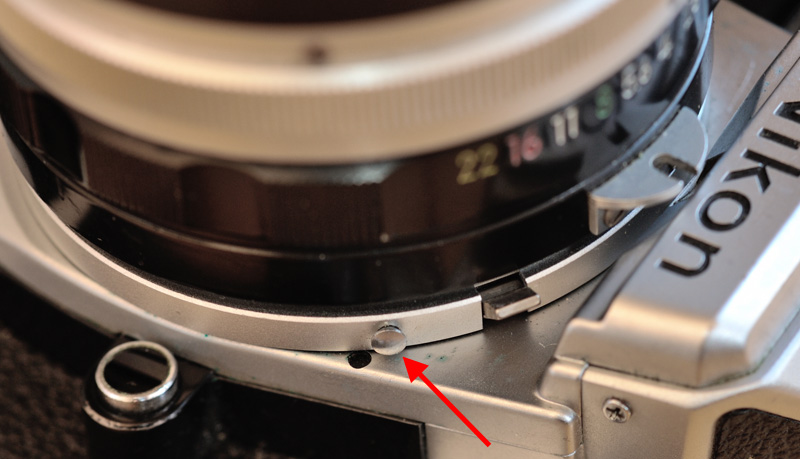
|
|
A non-AI lens mounted on a Nikon FE. You have to push the little button the red arrow points to in order to release the AI coupling for folding up. |
The problem is that the camera doesn't know the current aperture value the lens is set to. In the earlier models it was therefore necessary to use stop-down metering. For the Df Nikon's engineers have had a tricky idea: in the lens data you have to state that a non-CPU lens is a non-AI lens. If you then mount that lens, you must use the front command dial for telling the camera the aperture value you have selected on the lens. That means the photographer is the coupling between camera and lens. Matrix-metering, manual mode and aperture priority mode are available with such combinations.
I am afraid it was only a gag exclusively for the Df. The just announced D4s doesn't offer it. Too bad!